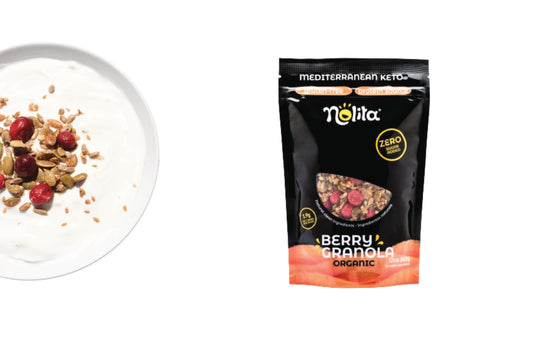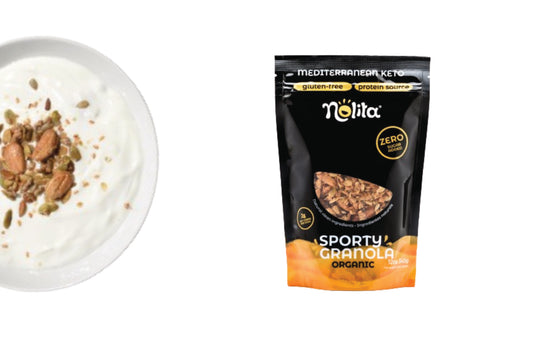The label is the identity card of a food. Knowing how to read it can be easy, but being able to interpret it is already more complicated. In this article, we'll help you take the hassle out of food labeling so you can make conscious food choices!
Nowadays, we are witnessing an increase in diseases related to an unbalanced diet. Therefore, it is imperative to promote good eating habits and combat the lack of literacy in health, nutrition and food (1).
At the time of purchase, our food choices are made in a few seconds. That said, knowing how to read and decipher labels is crucial to make the right decisions.
What is and where is food labeling?
Food labeling is the “set of mentions and indications, manufacturing or trade marks, images or symbols, referring to a foodstuff”. These may be “on any packaging, document, notice, label, ring or necklace accompanying or referring to that foodstuff” (2).
What should food labeling contain?
In Portugal (and in the European Union), economic operators are obliged to follow, among others, Regulation (EU) No. 1169/2011. This concerns the provision of information to consumers about pre-packaged foodstuffs, establishing mandatory information that must appear on the label. We will see, throughout this article, the specifics of this regulation.
As an example with one of Nolita's products, learn to identify the elements present in our packaging!

Image 1: Uncomplicate Nolita labels. 1-Net quantity;2-Commercial name; 3-Lot; 4-Minimum durability date; 5-Sales name; 6-Nutritional declaration; 7-List of ingredients and allergens; 8- Storage Conditions; 9-Bar code; 10-Green dot; 11-Organic product logo; 12-Name and address pf the entity; 13-Region of origin.
What is the nutrition declaration and what does it tell us?
The nutrition declaration is the table with the nutritional information on the back of the packaging, which is often presented per 100 g. It must contain the elements present in the following image (2):

Image 2: Nutritional declaration elements
As you saw on the packaging of our Crunchy granola, this statement can also be complemented with the amounts of polyols and fiber, among others. In other products, the percentages of the reference doses defined for an adult who ingests, on average, 2000 kcal/day are also seen (2).
Additionally, this declaration can be presented per portion and/or consumption unit, as long as the number on the package is shown on the label.
How to interpret the nutrition declaration?
Currently, several brands have already adopted various simplified nutrition labeling systems, such as the Nutri-Score or the nutritional traffic light, among others. These systems aim to simplify the nutritional information of each product, being present on the front of the packages for a quick and informed reading (3).
Unfortunately, to date, there is no standard for the widespread implementation of a single simplified nutrition labeling system. In addition, none of these various systems is consensual as to their benefits, nor does it stand out over the other, when compared to each other (4).
How to uncomplicate reading the nutrition declaration?
While there is no consensual simplified nutrition labeling system, it is essential to know how to interpret the nutrition declaration. For this, the General Directorate of Health (DGS), through the National Program for the Promotion of Healthy Eating (PNPAS), created the label decoder!
In order to simplify the reading of the table on the back of the packages, this tool was created. Through it, it is possible to uncomplicate all these numbers, both for food and drinks.


Image 3: labels decoder.
How to interpret the label decoder?
On these cards, you can see the low, medium and high values for each of the critical elements: fat, saturated fat, sugars and salt. Thus, it is intended to be able to compare their information with that on the label of food and drinks per 100 g or 100 ml.
Simply put, you should choose foods and beverages whose nutrients are mainly in the green category. With this, you should reduce the intake of those with one or more nutrients in the yellow zone and avoid those with one or more nutrients in the red category (5).
In addition to this, it is important that you also pay attention to the list of ingredients, which is presented in descending order of quantities. That is, the first ingredient that appears is present in greater quantity in the product and so on (2). That said, the simpler the list, the more accurate the choice you are making!
Conclusion to retain:
Thus, the food label (2):
-
is the identity card for pre-packaged foods;
-
it is essential for consumers to be able to make more conscious, informed and appropriate choices to their needs and preferences;
-
contributes to the safe and proper use of food and its correct storage, preparation and consumption;
-
contains the nutritional table on the back of the packages, ie the “nutrition declaration”. This must necessarily contain (per 100 g and/or portion): energy value, fats, saturated fats, carbohydrates, sugars, proteins and salt;
-
presents the amount of ingredients in descending order of quantity and the smaller its extension, the better your choice will be;
-
can be uncomplicated through the decoder created by DGS, which analyzes the information as found in the nutritional table (per 100 g or 100 ml). Opt for foods that contain nutrients that are mostly found in the green category!
Photo: Gustavo Fring
Bibliography:
1. Real H, Torres R. Literacia Nutricional e Literacia Alimentar: Uma Revisão narrativa sobre Definição, Domínios e Ferramentas de Avaliação. 2021.
2. Real H, Tristão I, Barbosa M. Rotulagem alimentar: um guia para uma escolha consciente, Coleção E-books APN: N. o 42, março de 2017. Associação Portuguesa dos Nutricionistas. 2017.
3. Nutrição APd. Um olhar sobre os sistemas de rotulagem alimentar Front of Pack (FOP). 2019.
4. Graça P, Silva AJ, Vieira CP, Sena C, Gregório MJ, Nogueira PJ, et al. Nutr-HIA Improving nutrition labelling in Portugal health impact assessment. 2019
5. Saúde DGd. Descodificador de Rótulos. 2022. Available in: https://alimentacaosaudavel.dgs.pt/descodificador-de-rotulos/.





